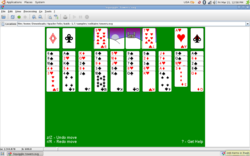Apache Batik
 | |
| Developer(s) | Apache Software Foundation |
|---|---|
| Stable release | 1.8
/ March 17, 2015 |
| Repository | |
| Written in | Java |
| Operating system | Cross-platform |
| Type | Scalable Vector Graphics (SVG) |
| License | Apache License 2.0 |
| Website | xmlgraphics |
Batik is a pure-Java library that can be used to render, generate, and manipulate SVG graphics. (SVG is an XML markup language for describing two-dimensional vector graphics.) IBM supported the project and then donated the code to the Apache Software Foundation, where other companies and teams decided to join efforts. Batik provides a set of core modules that provide functionality to:
- Render and dynamically modify SVG content,
- Transcode SVG content to some raster Graphics file formats, such as PNG, JPEG and TIFF,
- Transcode Windows Metafiles to SVG (WMF or Windows Metafile Format is the vector format used by Microsoft Windows applications),
- And manage scripting and user events on SVG documents.
The Batik distribution also contains a ready-to-use SVG browser (called Squiggle) making use of the above modules.
The name of the library comes from the Batik painting technique.
Status
Batik was long the most conformant existing SVG 1.1 implementation[1][2][3] and as of 2011[update] is just a small fraction behind Opera.[citation needed]
The latest 1.7 version, made available on January 10, 2008, has an "almost full" implementation of the current state of the sXBL specification,[4] a nearly complete implementation of SVG declarative animation SMIL features, and some of the SVG 1.2 late October 2004 working draft (see SVG's Development history).
See also
- Scalable Vector Graphics
- Synchronized Multimedia Integration Language
- sXBL : a mechanism for defining the presentation and interactive behavior of elements described in a namespace other than SVG's
- Comparison of layout engines (SVG)
References
- ^ Batik 1.7 Status
- ^ Schiller, Jeff (2009-01-18). "Welcome To CodeDread 1.1". Archived from the original on 16 February 2009. Retrieved 2009-02-08.
{{cite web}}: Unknown parameter|deadurl=ignored (|url-status=suggested) (help) - ^ almost 94% of the official SVG tests are OK with the 1.7 version.
- ^ Batik 1.7 Readme Archived April 9, 2008, at the Wayback Machine

